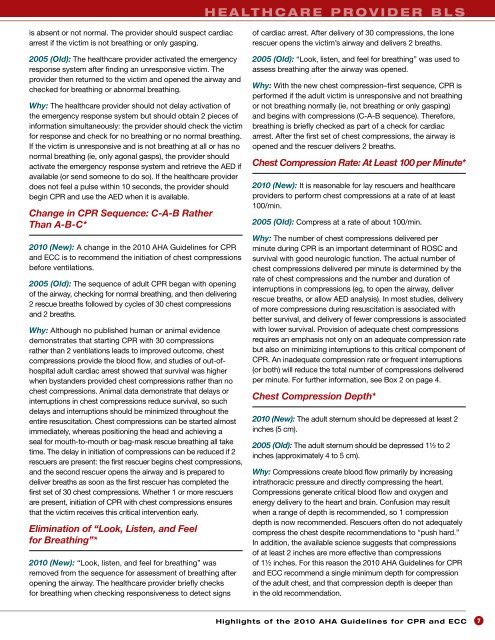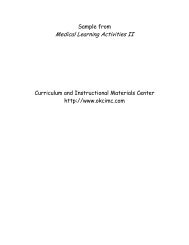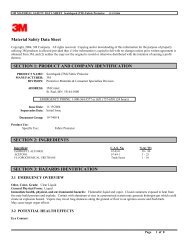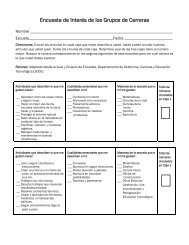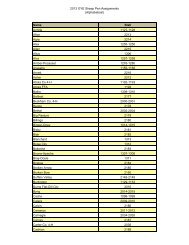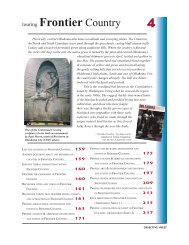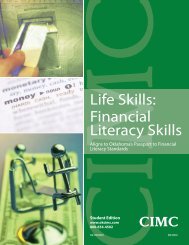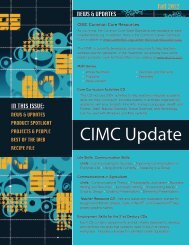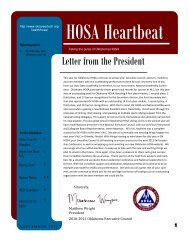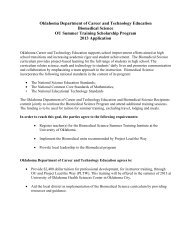Highlights of the 2010 Guidelines for CPR and ECC - ECC Guidelines
Highlights of the 2010 Guidelines for CPR and ECC - ECC Guidelines
Highlights of the 2010 Guidelines for CPR and ECC - ECC Guidelines
You also want an ePaper? Increase the reach of your titles
YUMPU automatically turns print PDFs into web optimized ePapers that Google loves.
H e a lt h C a r e P r o v i d e r b l s<br />
is absent or not normal. The provider should suspect cardiac<br />
arrest if <strong>the</strong> victim is not breathing or only gasping.<br />
2005 (Old): The healthcare provider activated <strong>the</strong> emergency<br />
response system after finding an unresponsive victim. The<br />
provider <strong>the</strong>n returned to <strong>the</strong> victim <strong>and</strong> opened <strong>the</strong> airway <strong>and</strong><br />
checked <strong>for</strong> breathing or abnormal breathing.<br />
Why: The healthcare provider should not delay activation <strong>of</strong><br />
<strong>the</strong> emergency response system but should obtain 2 pieces <strong>of</strong><br />
in<strong>for</strong>mation simultaneously: <strong>the</strong> provider should check <strong>the</strong> victim<br />
<strong>for</strong> response <strong>and</strong> check <strong>for</strong> no breathing or no normal breathing.<br />
If <strong>the</strong> victim is unresponsive <strong>and</strong> is not breathing at all or has no<br />
normal breathing (ie, only agonal gasps), <strong>the</strong> provider should<br />
activate <strong>the</strong> emergency response system <strong>and</strong> retrieve <strong>the</strong> AED if<br />
available (or send someone to do so). If <strong>the</strong> healthcare provider<br />
does not feel a pulse within 10 seconds, <strong>the</strong> provider should<br />
begin <strong>CPR</strong> <strong>and</strong> use <strong>the</strong> AED when it is available.<br />
Change in <strong>CPR</strong> Sequence: C-A-B Ra<strong>the</strong>r<br />
Than A-B-C*<br />
<strong>2010</strong> (New): A change in <strong>the</strong> <strong>2010</strong> AHA <strong>Guidelines</strong> <strong>for</strong> <strong>CPR</strong><br />
<strong>and</strong> <strong>ECC</strong> is to recommend <strong>the</strong> initiation <strong>of</strong> chest compressions<br />
be<strong>for</strong>e ventilations.<br />
2005 (Old): The sequence <strong>of</strong> adult <strong>CPR</strong> began with opening<br />
<strong>of</strong> <strong>the</strong> airway, checking <strong>for</strong> normal breathing, <strong>and</strong> <strong>the</strong>n delivering<br />
2 rescue breaths followed by cycles <strong>of</strong> 30 chest compressions<br />
<strong>and</strong> 2 breaths.<br />
Why: Although no published human or animal evidence<br />
demonstrates that starting <strong>CPR</strong> with 30 compressions<br />
ra<strong>the</strong>r than 2 ventilations leads to improved outcome, chest<br />
compressions provide <strong>the</strong> blood flow, <strong>and</strong> studies <strong>of</strong> out-<strong>of</strong>hospital<br />
adult cardiac arrest showed that survival was higher<br />
when byst<strong>and</strong>ers provided chest compressions ra<strong>the</strong>r than no<br />
chest compressions. Animal data demonstrate that delays or<br />
interruptions in chest compressions reduce survival, so such<br />
delays <strong>and</strong> interruptions should be minimized throughout <strong>the</strong><br />
entire resuscitation. Chest compressions can be started almost<br />
immediately, whereas positioning <strong>the</strong> head <strong>and</strong> achieving a<br />
seal <strong>for</strong> mouth-to-mouth or bag-mask rescue breathing all take<br />
time. The delay in initiation <strong>of</strong> compressions can be reduced if 2<br />
rescuers are present: <strong>the</strong> first rescuer begins chest compressions,<br />
<strong>and</strong> <strong>the</strong> second rescuer opens <strong>the</strong> airway <strong>and</strong> is prepared to<br />
deliver breaths as soon as <strong>the</strong> first rescuer has completed <strong>the</strong><br />
first set <strong>of</strong> 30 chest compressions. Whe<strong>the</strong>r 1 or more rescuers<br />
are present, initiation <strong>of</strong> <strong>CPR</strong> with chest compressions ensures<br />
that <strong>the</strong> victim receives this critical intervention early.<br />
Elimination <strong>of</strong> “Look, Listen, <strong>and</strong> Feel<br />
<strong>for</strong> Breathing”*<br />
<strong>2010</strong> (New): “Look, listen, <strong>and</strong> feel <strong>for</strong> breathing” was<br />
removed from <strong>the</strong> sequence <strong>for</strong> assessment <strong>of</strong> breathing after<br />
opening <strong>the</strong> airway. The healthcare provider briefly checks<br />
<strong>for</strong> breathing when checking responsiveness to detect signs<br />
<strong>of</strong> cardiac arrest. After delivery <strong>of</strong> 30 compressions, <strong>the</strong> lone<br />
rescuer opens <strong>the</strong> victim’s airway <strong>and</strong> delivers 2 breaths.<br />
2005 (Old): “Look, listen, <strong>and</strong> feel <strong>for</strong> breathing” was used to<br />
assess breathing after <strong>the</strong> airway was opened.<br />
Why: With <strong>the</strong> new chest compression–first sequence, <strong>CPR</strong> is<br />
per<strong>for</strong>med if <strong>the</strong> adult victim is unresponsive <strong>and</strong> not breathing<br />
or not breathing normally (ie, not breathing or only gasping)<br />
<strong>and</strong> begins with compressions (C-A-B sequence). There<strong>for</strong>e,<br />
breathing is briefly checked as part <strong>of</strong> a check <strong>for</strong> cardiac<br />
arrest. After <strong>the</strong> first set <strong>of</strong> chest compressions, <strong>the</strong> airway is<br />
opened <strong>and</strong> <strong>the</strong> rescuer delivers 2 breaths.<br />
Chest Compression Rate: At Least 100 per Minute*<br />
<strong>2010</strong> (New): It is reasonable <strong>for</strong> lay rescuers <strong>and</strong> healthcare<br />
providers to per<strong>for</strong>m chest compressions at a rate <strong>of</strong> at least<br />
100/min.<br />
2005 (Old): Compress at a rate <strong>of</strong> about 100/min.<br />
Why: The number <strong>of</strong> chest compressions delivered per<br />
minute during <strong>CPR</strong> is an important determinant <strong>of</strong> ROSC <strong>and</strong><br />
survival with good neurologic function. The actual number <strong>of</strong><br />
chest compressions delivered per minute is determined by <strong>the</strong><br />
rate <strong>of</strong> chest compressions <strong>and</strong> <strong>the</strong> number <strong>and</strong> duration <strong>of</strong><br />
interruptions in compressions (eg, to open <strong>the</strong> airway, deliver<br />
rescue breaths, or allow AED analysis). In most studies, delivery<br />
<strong>of</strong> more compressions during resuscitation is associated with<br />
better survival, <strong>and</strong> delivery <strong>of</strong> fewer compressions is associated<br />
with lower survival. Provision <strong>of</strong> adequate chest compressions<br />
requires an emphasis not only on an adequate compression rate<br />
but also on minimizing interruptions to this critical component <strong>of</strong><br />
<strong>CPR</strong>. An inadequate compression rate or frequent interruptions<br />
(or both) will reduce <strong>the</strong> total number <strong>of</strong> compressions delivered<br />
per minute. For fur<strong>the</strong>r in<strong>for</strong>mation, see Box 2 on page 4.<br />
Chest Compression Depth*<br />
<strong>2010</strong> (New): The adult sternum should be depressed at least 2<br />
inches (5 cm).<br />
2005 (Old): The adult sternum should be depressed 1½ to 2<br />
inches (approximately 4 to 5 cm).<br />
Why: Compressions create blood flow primarily by increasing<br />
intrathoracic pressure <strong>and</strong> directly compressing <strong>the</strong> heart.<br />
Compressions generate critical blood flow <strong>and</strong> oxygen <strong>and</strong><br />
energy delivery to <strong>the</strong> heart <strong>and</strong> brain. Confusion may result<br />
when a range <strong>of</strong> depth is recommended, so 1 compression<br />
depth is now recommended. Rescuers <strong>of</strong>ten do not adequately<br />
compress <strong>the</strong> chest despite recommendations to “push hard.”<br />
In addition, <strong>the</strong> available science suggests that compressions<br />
<strong>of</strong> at least 2 inches are more effective than compressions<br />
<strong>of</strong> 1½ inches. For this reason <strong>the</strong> <strong>2010</strong> AHA <strong>Guidelines</strong> <strong>for</strong> <strong>CPR</strong><br />
<strong>and</strong> <strong>ECC</strong> recommend a single minimum depth <strong>for</strong> compression<br />
<strong>of</strong> <strong>the</strong> adult chest, <strong>and</strong> that compression depth is deeper than<br />
in <strong>the</strong> old recommendation.<br />
<strong>Highlights</strong> <strong>of</strong> <strong>the</strong> <strong>2010</strong> AHA <strong>Guidelines</strong> <strong>for</strong> <strong>CPR</strong> <strong>and</strong> <strong>ECC</strong> 7


